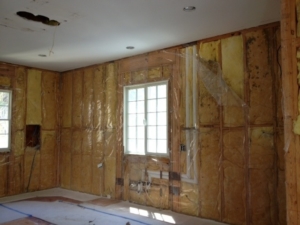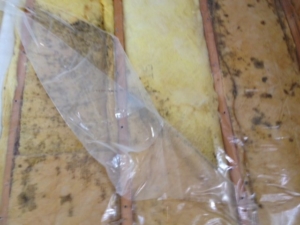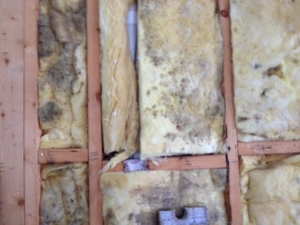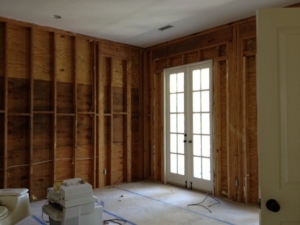The Components in a Wall

When we removed the drywall we exposed the 6 mil poly vapor barrier and the insulation
When I was a young intern in Canada, the construction of the exterior walls on houses was very straightforward and once you got past the variation of exterior finish (brick, wood siding, vinyl siding etc) it was all the same: sheathing on the outside of the wood studs, fiberglass batt insulation in the stud cavity, 6 mil poly vapor barrier, drywall on the inside.
This type of wall was built everywhere. Ontario, British Columbia, Minnesota, Maine and South Carolina. You have probably seen it on homes built after the 70’s. And it was a wall type that served very well in cold places like Canada and in our northern states.
The Building Envelope
But these were the days before we had researches studying exterior building envelopes and before we understood how different climates have different conditions. These were the days before we understood that one wall design does not perform equally well in Minnesota and South Carolina.
Let me share a story.
Where Mold Likes to Grow

Trapped moisture behind the vapor barrier led to the growth of mold
Construction has just started on a renovation project of ours on a 30 year old home on Sullivan’s Island. It was a home built by a builder for himself….and you know a builder would not intentionally build something bad for himself. But this is what we found: MOLD!
When we took down the drywall on the exterior walls we intended to remove for an addition, we could see the plastic vapor barrier over the fiberglass insulation. And the plastic had created the perfect conditions for moisture to get trapped in the wall. The result? Mold. And lots of it.
Sadly, our homeowners suddenly have bigger construction project. We need to remove all of the interior finish on all of the exterior walls, so we can remove all of the plastic vapor barrier and all of the moldy batt insulation. Some of the wood studs and sheathing will need to be replaced. And we need to treat for mold. then we have to add new insulation and new interior finishes. It is a lot of work and expense without any visible change or improvement.

Almost every stud space had mold
Could we have left it? Technically, yes. The homeowner could have decided they did not want to bear the cost, and that they were in good enough health that mold exposure wouldn’t hurt them. And that they were willing to disclose it when they sold the home. But we were replacing all of the windows and doing enough additions with new exterior walls that the whole building envelope would have been much, much, tighter…which would have increased the potential for moisture trapped behind the plastic vapor barrier….which would have increased the potential for more mold growth. Which would have increased the potential for an adverse effect on their health.
And that was too big a cost for our homeowners to bear!
A Better Wall?

We removed all of the 6 mil poly vapor barrier and all of the insulation on the exterior walls. Removing mold damaged framing is the next step.
So what is one good way to build a wall on Sullivan’s Island? Use fiberglass batt insulation with paper backing leave off the plastic vapor barrier.
We now know many ways to build a good wall (tied into a good building envelope), and it varies from place to place depending on the climate conditions. For more discussion about good walls, stay tuned for a future blog post.

